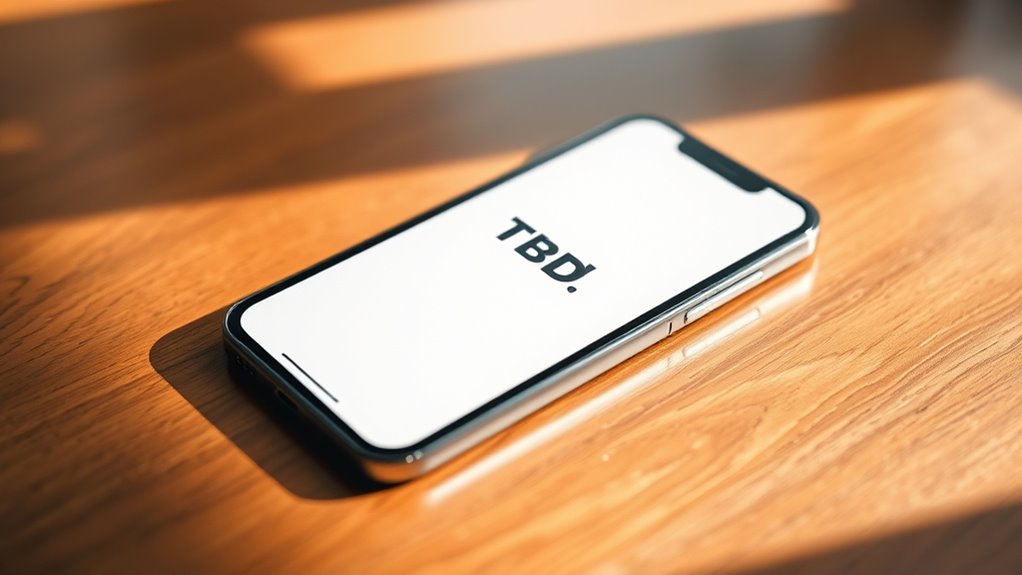In text, “TBD” stands for “To Be Determined,” used to show that details like dates, locations, or decisions haven’t been finalized yet. It’s common in schedules, plans, and informal messages when expectations are still uncertain. Recognizing “TBD” helps you understand that some information is still pending, whether for events or projects. If you keep exploring, you’ll learn how this abbreviation is used across different situations and how to interpret its meaning accurately.
Key Takeaways
- “TBD” stands for “To Be Determined,” indicating an undecided or unspecified detail.
- It is commonly used in text to show that information like date, location, or decision is pending.
- “TBD” signals ongoing planning or decision-making in messages and discussions.
- The abbreviation suggests flexibility and that more details will be provided later.
- Recognizing “TBD” helps interpret incomplete information accurately in digital communication.
The Origin of the Term “TBD”
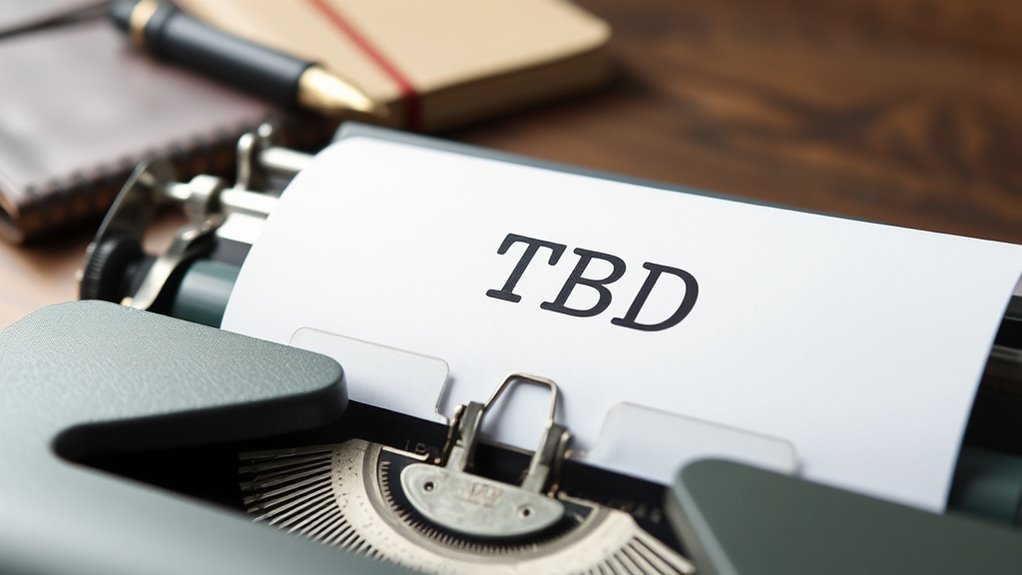
The term “TBD” stands for “To Be Determined,” and its origins trace back to the early days of business and project planning. Its history origins are rooted in the need for flexible scheduling and decision-making, especially in project management. Linguistic etymology reveals that “To Be Determined” emerged as a practical phrase used by professionals to indicate incomplete details that would be finalized later. Over time, this abbreviation gained popularity in charts, reports, and planning documents, reflecting an ongoing process rather than a fixed outcome. Its concise form helped streamline communication across industries, making it easier to note pending decisions. Today, while “TBD” mainly appears in informal contexts, its roots remain deeply embedded in the structured language of planning and organization. Additionally, understanding home improvement concepts can help in managing projects with flexible timelines and evolving details.
Common Uses of “TBD” in Conversations

You often see “TBD” when making plans or setting schedules, signaling that details are still being finalized. It’s also used to express uncertain intentions, leaving room for flexibility. Understanding these common uses helps you interpret conversations more accurately and avoid confusion. Additionally, “TBD” may indicate ongoing decision-making processes that require further clarification before final commitments.
Scheduling and Plans
Scheduling and plans often rely on the abbreviation “TBD” to indicate that details are still to be decided. When you’re coordinating events or meetings, “TBD” signals that there’s flexibility in timing or location, allowing for scheduling flexibility as plans develop. It also highlights planning uncertainty, meaning the specifics haven’t been finalized yet. Using “TBD” helps manage expectations, showing that arrangements might shift as more information becomes available. This shorthand is especially useful when coordinating with multiple people or adapting to changing circumstances, making it clear that details are still open. By marking uncertain elements as “TBD,” you keep plans adaptable while avoiding premature commitments. It’s a practical way to communicate that details will be confirmed later. Additionally, understanding related concepts like planning uncertainty can help in effectively managing expectations and timelines.
Ambiguous Intentions
When someone uses “TBD” in a conversation about their intentions, it often signals ambiguity or indecision. You might notice they’re leaving plans open-ended, with uncertain plans or vague commitments. This suggests they haven’t finalized details or are unsure about their availability. Using “TBD” indicates they prefer to keep options flexible or avoid making firm promises. It can also reflect a desire to delay commitment until more information is available. In these cases, your counterpart may be hesitant, unsure, or simply unwilling to specify their intentions at the moment. Recognizing this can help you understand their motivation—whether they’re avoiding commitment, testing options, or simply unsure of their schedule. Additionally, understanding the importance of community resilience can influence how you interpret such ambiguous signals, especially in planning for uncertain situations. It’s a way of signaling that their plans are still in flux.
“TBD” in Business and Project Planning
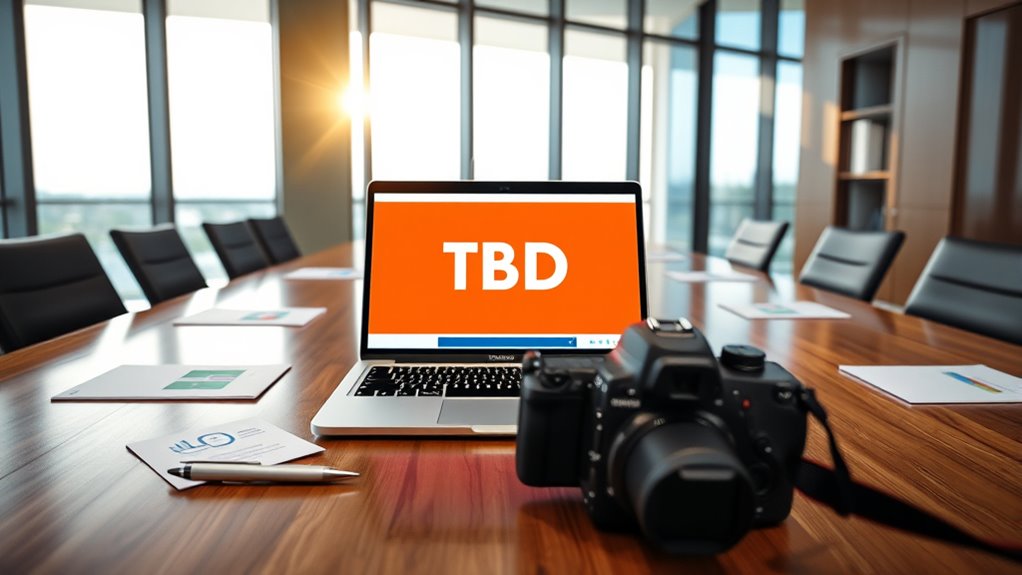
In business and project planning, using “TBD” helps you clarify unfinished tasks and outline future milestones. It communicates uncertain details clearly, so everyone understands what’s still in progress. Recognizing how “TBD” functions in these contexts keeps your projects organized and flexible.
Clarifying Unfinished Tasks
Have you ever encountered a task marked as “TBD” in a project plan and wondered what it really means? When you see “TBD,” it indicates an unfinished task that needs further clarification before moving forward. Effective task management involves identifying these ambiguous items and resolving them promptly. To ensure progress, communicate clearly with your team about what remains unknown, who is responsible for clarifying it, and when it should be resolved. This process helps prevent confusion and keeps everyone aligned. Clarifying unfinished tasks minimizes delays and improves project flow. Remember, “TBD” isn’t a placeholder for neglect—it’s an invitation to seek clarity, refine objectives, and ensure your project stays on track. Clear communication is essential for turning “TBD” into actionable steps. Additionally, understanding the role of cookie categories can help streamline communication and data sharing within your team.
Setting Future Milestones
Setting future milestones is a vital step in turning unfinished tasks marked as “TBD” into concrete goals that guide your project forward. Effective milestone planning helps you break down complex projects into manageable steps, giving clear direction and deadlines. By defining specific milestones, you create a roadmap that aligns your team and keeps everyone accountable. Goal setting during this process ensures each milestone is realistic and measurable, helping you track progress accurately. Focus on setting priorities, establishing achievable deadlines, and connecting each milestone to your overall objectives. This proactive approach prevents ambiguity and keeps your project on track. With well-planned milestones, you turn vague “TBD” labels into actionable targets that drive your project toward successful completion. Recognizing signs of spoilage in related tasks can help you identify potential issues early and adjust your plans accordingly.
Communicating Uncertain Details
How do you effectively communicate uncertain details marked as “TBD” in business and project planning? When plans are uncertain, it’s vital to set expectations clearly. Use transparent language to explain that some components are still being finalized, emphasizing your commitment to flexibility. Highlight the importance of adaptable timelines and scope adjustments. Consider these strategies:
- Clearly label items as “TBD” to acknowledge uncertain plans.
- Communicate that flexible commitments may evolve as more information becomes available.
- Provide regular updates to keep stakeholders informed about progress and changes.
- Recognize the nutrients in vegetable juices that support health, which can help justify flexible planning around wellness initiatives.
How “TBD” Is Interpreted in Social Media Posts
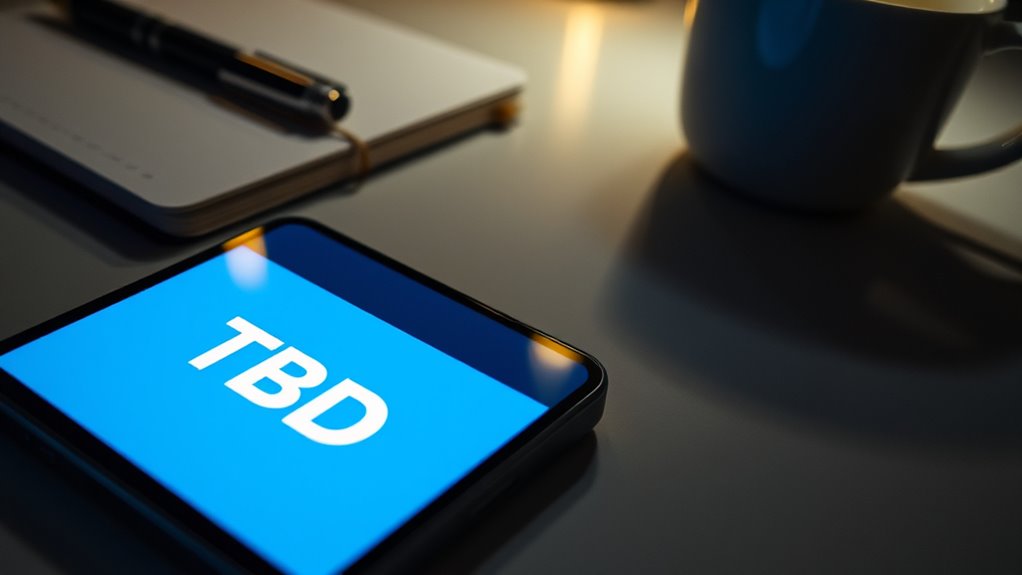
In social media posts, “TBD” is often used to indicate that a decision, detail, or event is still pending or undecided. This abbreviation helps users communicate uncertainty quickly, fitting the fast pace of digital communication. When you see “TBD” on social media, it usually signals that more information will come later, and the post is just a placeholder until details are finalized. Using “TBD” also aligns with social media etiquette by respecting transparency and clarity. It shows you’re honest about the current state of plans or events without committing prematurely. This shorthand keeps conversations efficient and avoids unnecessary speculation. Overall, “TBD” helps manage expectations and maintains effective communication within social media communities. Incorporating mindfulness and consistent practice can also improve clarity and reduce ambiguity when sharing updates.
Variations and Similar Abbreviations to “TBD”

Several abbreviations and variations resemble “TBD” to express uncertainty or pending decisions. These abbreviation variations often appear in similar contexts, helping you understand related terminology quickly. For example:
Various abbreviations like TBA and TBC signal pending details or confirmations, helping clarify uncertainties.
- “TBA” (To Be Announced): indicates details will be revealed later.
- “TBC” (To Be Confirmed): suggests plans are tentative and need confirmation.
- “TBD” itself can have slight variations like “TBDs” for multiple items.
These related terminology options let you grasp the nuance behind each abbreviation. Recognizing these variations helps you interpret messages more accurately, especially when planning or discussing unresolved topics. Knowing the subtle differences ensures clear communication and prevents misunderstandings in both casual and professional settings. Additionally, understanding drivetrain components can help clarify the context when discussing bike-related abbreviations.
Tips for Deciphering Online Abbreviations Like “TBD”

Deciphering online abbreviations like “TBD” can be straightforward if you know what clues to look for. Pay attention to the tone, context, and platform, as these reveal clues about digital slang’s abbreviation evolution. To improve your decoding skills, consider these tips:
| Tip | Explanation |
|---|---|
| Recognize common patterns | Many abbreviations follow familiar structures, making them easier to interpret. |
| Observe context | The surrounding conversation helps clarify the abbreviation’s meaning. |
| Stay updated | Digital slang evolves rapidly; keeping up with trends ensures better understanding. |
| Learn about ethical hacking concepts | Understanding cybersecurity terminology can help interpret related abbreviations more accurately. |
The Importance of Context When Using “TBD”
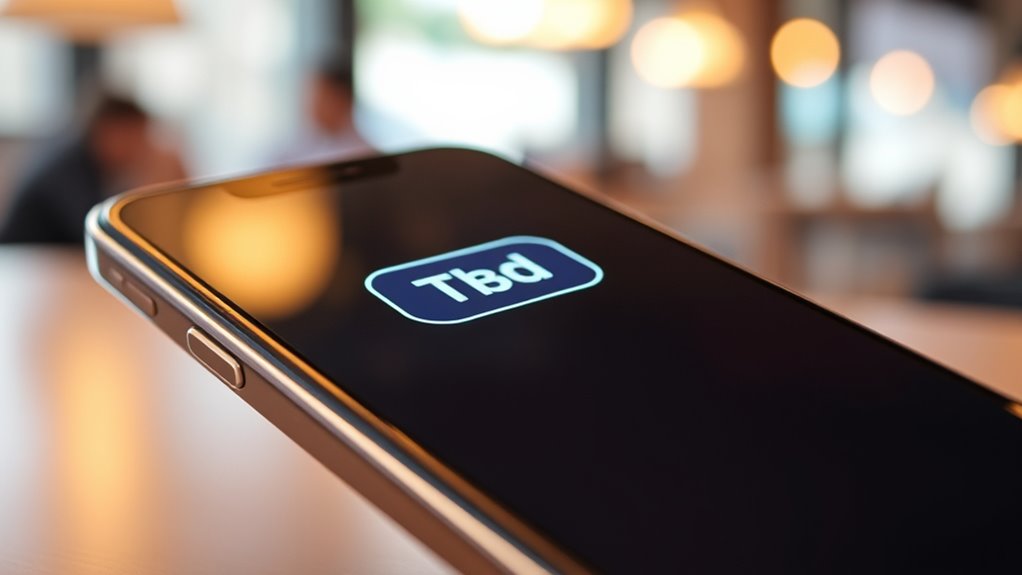
Understanding the context in which “TBD” is used is essential because it often determines its specific meaning. Cultural differences can influence how “TBD” is interpreted, especially in international communication. As language evolves, abbreviations like “TBD” may carry different nuances depending on the setting. For example, in professional emails, it might mean a project’s future date, while among friends, it could be a placeholder for plans yet to be decided. Recognizing these variations helps prevent misunderstandings. Keep in mind:
- Cultural norms shape abbreviation use and meaning
- Language evolution introduces new uses and interpretations
- Context clarifies whether “TBD” refers to a scheduled event or an open-ended idea
Additionally, understanding retirement planning strategies can help individuals make more informed decisions about their long-term financial goals.
Examples of “TBD” in Everyday Communication

In everyday conversations, “TBD” frequently appears in informal messages, social media posts, and planning discussions. It’s a common textual abbreviation used in digital communication to indicate that details are still undecided. For example, when friends plan a weekend outing, they might say, “Where should we meet? TBD.” Here’s a visual to help you picture typical uses:
| Event Planning | Social Media | Workplace Discussions |
|---|---|---|
| “Location: TBD” | “Party date: TBD” | “Next meeting: TBD” |
| “Dinner time: TBD” | “Vacation plans: TBD” | “Project deadline: TBD” |
| “Movie night: TBD” | “Group chat: TBD” | “Budget approval: TBD” |
These examples show how “TBD” helps manage expectations across different digital communication scenarios. Additionally, understanding digital communication can enhance your ability to interpret and respond to these messages effectively.
Frequently Asked Questions
Is “Tbd” Always Used for Scheduling Purposes?
TBD is mainly used for scheduling purposes, but it can also appear in alternative contexts like project planning or discussions where details are still undecided. You’ll often see it as an abbreviation variation for “to be determined” or “to be decided.” While scheduling is common, don’t assume it’s limited to that; it’s flexible and can signal any information awaiting clarification or finalization.
Can “Tbd” Be Used in Formal Writing?
In formal contexts, you shouldn’t use “TBD” in professional communication. Think of “TBD” as a placeholder like a question mark in a finished painting—it’s meant for drafts, not final presentations. When scheduling or clarifying details in formal writing, specify the information or say “to be determined” explicitly. This guarantees your message remains clear, respectful of professionalism, and leaves no room for ambiguity in serious discussions or official documents.
Are There Culturally Specific Meanings for “Tbd”?
You might find that cultural interpretations and regional variations influence how people view “TBD.” In some cultures, it’s seen as a placeholder for uncertainty, while others may interpret it as a sign of indecision or delay. Regional slang or professional contexts can also shape its meaning. So, it’s good to be aware that “TBD” can carry different connotations depending on where and how it’s used, reflecting local communication styles.
How Does “Tbd” Differ From “Tba”?
Think of “TBD” as an unfinished puzzle piece, while “TBA” is a plan still being shaped. In project planning, “TBD” signals completion deadlines or details still undefined, leaving aspects open. Conversely, “TBA” indicates a date or detail will be announced later, like a placeholder. Both help manage expectations, but “TBD” shows ongoing decision-making, whereas “TBA” promises future clarification.
Is “Tbd” Ever Used Humorously or Sarcastically?
Yes, you can use “tbd” humorously or sarcastically, especially among friends or colleagues. People often play with humorous abbreviations or sarcastic expressions to lighten the mood or poke fun at uncertainty. For example, you might say something is “tbd” when it’s clearly obvious or when you’re joking about how long a task will take. It’s a playful way to acknowledge ambiguity while adding a touch of humor or sarcasm.
Conclusion
Understanding “TBD” is like deciphering a secret code in a vast conversation jungle. When you grasp its meaning and context, you gain clarity and confidence, steering messages with ease. Just as a lighthouse guides ships through foggy waters, knowing what “TBD” stands for helps you navigate conversations and plans smoothly. Keep this knowledge close, and you’ll never feel lost in the maze of online abbreviations again.
